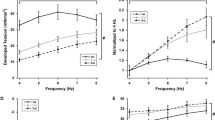Summary
In order to investigate the mechanism by which elevated extracellular calcium ions decrease tetanus tension in frog skeletal muscle, we made mechanical, electrophysiological and photographic measurements on single fibres or small bundles of fibres. Three lines of evidence point to t-tubular conduction failure as the primary mechanism of action of high calcium. They are (1) a decrease in amplitude of the late afterpotential, (2) attentuation or elimination of the notch and hump configuration of the early afterpotential, and (3) the appearance of wavy myofibrils in the axial core of fibres during tetanus. These effects are fully reversible and are shared by other bivalent cations. High calcium concentration causes a change in the time course of the early afterpotential but does not alter the passive cell membrane characteristics, as reflected by the time course of decay of applied hyperpolarizing pulses.
Similar content being viewed by others
References
Adrian, R. H. &Peachey, L. D. (1973) Reconstruction of the action potential of frog sartorius muscle.J. Physiol., Lond. 235, 103–31.
Bezanilla, F., Caputo, C., Gonzalez-Serratos, H. &Venosa, R. A. (1972) Sodium dependence of the inward spread of activation in isolated twitch muscle fibres of the frog.J. Physiol., Lond. 233, 507–23.
Bianchi, C. P. &Narayan, S. (1982a) Muscle fatigue and the role of the transverse tubules.Science 215, 295–6.
Bianchi, C. P. &Narayan, S. (1982b) Possible role of the transverse tubules in accumulating calcium released from the terminal cisternae by stimulation and drugs.Canad. J. Physiol. Pharmacol. 60, 503–7.
Brown, L., Gonzalez-Serratos, H. &Huxley, A. F. (1984) Structural studies of the waves in striated muscle fibres shortened passively below their slack length.J. Musc. Res. Cell Motility 5, 273–92.
Frankenhaueser, B. &Lännergren, J. (1967) The effect of calcium on the mechanical response of single twitch muscle fibres ofXenopus laevis.Acta Physiol. Scand 69, 242–54.
Freygang, W. H., Goldstein, D. A. &Hellam, D. C. (1964a) The after-potential that follows trains of impulses in frog muscle fibers.J. gen. Physiol. 47, 929–52.
Freygang, W. H., Goldstein, D. A., Hellam, D. C. &Peachey, L. D. (1964b) The relation between the late after-potential and the size of the transverse tubular system of frog muscle.J. gen. Physiol. 48, 235–63.
Gage, P. W. &Eisenberg, R. S. (1969) Action potentials, afterpotentials, and excitation-contraction coupling in frog sartorius fibers without transverse tubules.J. gen. Physiol. 53, 298–310.
Gonzalez-Serratos, H. (1966) Inward spread of contraction during a twitch.J. Physiol. Lond. 185, 20–21P.
Gonzalez-Serratos, H. (1971) Inward spread of activation in vertebrate muscle fibres.J. Physiol. Lond. 212, 777–99.
Gonzalez-Serratos, H. (1983) Inward spread of activation in twitch skeletal muscle fibers. InHandbook of Physiology, Section 10 (edited byPeachey, L.) American Physiological Society.
Gonzalez-Serratos, H., delCarmen Garcia, M., Somlyo, A., Somlyo, A. P. &Mcclellan, G. (1981) Differential shortening of myofibrils during development of fatigue.Biophys. J. 33, 224a.
Gordon, A. M., Huxley, A. F. &Julian, F. J. (1966) The variation in isometric tension with sarcomere length in vertebrate muscle fibres.J. Physiol. Lond. 184, 170–92.
Heiny, J. A. &Vergara, J. (1982) Optical signals from surface and T system membranes in skeletal muscle fibers.J. gen. Physiol. 80, 203–30.
Hellam, D. C., Goldstein, D. A., Peachey, L. D. &Freygang, W. H. (1965) The suppression of the late after-potential in rubidium-containing frog muscle fibers.J. gen. Physiol. 48, 1003–10.
Hille, B., Woodhull, A. M. &Shapiro, B. I. (1975) Negative surface charge near sodium channels of nerve: divalent ions, monovalent ions, and pH.Philos. Trans. Roy. Soc. Lond. B270, 301–18.
Howell, J. N., Howell, S. G., Shankar, A. &Wei, F. (1982) Evidence for t-tubular conduction failure in frog muscle in the presence of elevated extracellular Ca2+ concentration.Biophys. J. 37, 123a.
Howell, J. N. &Jenden, D. J. (1967) T-tubules of skeletal muscle: morphological alterations which interrupt excitation-contraction coupling.Fedn. Proc. 26, 553.
Howell, J. N., Shankar, A. &Molefhe, T. (1983) Effects of elevated extracellular calcium on early and late afterpotentials in frog skeletal muscle.Biophys. J. 41, 180a.
Howell, J. N. &Snowdowne, K. W. (1981) Inhibition of tetanus tension by elevated extracellular calcium concentration.Am. J. Physiol. 240, C193-C200.
Huxley, A. F. &Gordon, A. M. (1962) Striation pattern in active and passive shortening of muscle.Nature, Lond. 193, 280–1.
Kirsch, G. E., Nichols, R. A. &Nakajima, S. (1977) Delayed rectification in the transverse tubules. Origin of the late afterpotential in frog skeletal muscle.J. gen. Physiol. 70, 1–22.
Lüttgau, H. C. (1963) The action of calcium ion on potassium contractures of single muscle fibres.J. Physiol. Lond. 168, 679–97.
Persson, A. (1963) The negative after-potential of frog skeletal muscle fibres.Acta Physiol. Scand. 58, Suppl.205, 3–32.
Sandow, A. (1964) Potentiation of muscular contraction.Archs phys. med. Rehab. 45, 62–1.
Taylor, S. R. &Rüdel, R. (1970) Striated muscle fibers: inactivation of contraction induced by shortening.Science, N.Y. 167, 882–4.
Author information
Authors and Affiliations
Rights and permissions
About this article
Cite this article
Howell, J.N., Shankar, A., Howell, S.G. et al. Evidence for t-tubular conduction failure in frog skeletal muscle induced by elevated extracellular calcium concentration. J Muscle Res Cell Motil 8, 229–241 (1987). https://doi.org/10.1007/BF01574591
Revised:
Issue Date:
DOI: https://doi.org/10.1007/BF01574591




